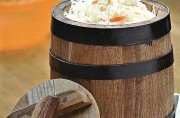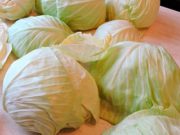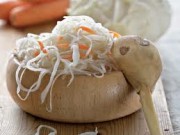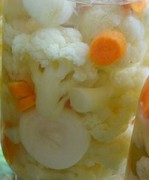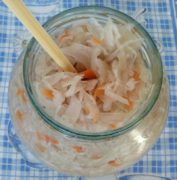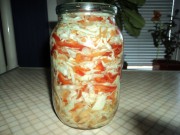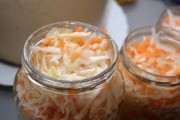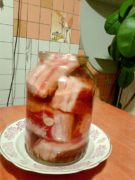How to salt cabbage for the winter at home - proper salting of cabbage in a jar or barrel.
Homemade pickling of cabbage for the winter is a process that seems to have been known for a long time for all of us. But are you doing everything right and how tasty is your sauerkraut? In this recipe, I will try to explain in detail how to salt cabbage, what processes occur during fermentation and what to do so that the cabbage does not become acidic or bitter, but always remains fresh - tasty and crispy.
And so, how to pickle cabbage for the winter at home correctly.

Let's start with the fact that mid- and late-ripening cabbage varieties are suitable for pickling. We clean the cabbage heads, cut off the stalk, remove the top leaves, wash them, cut them into 4 parts and finely chop them.
We also finely chop (shred on a coarse grater) the carrots. You can also add whole or chopped apples to the cabbage; the Antonovka variety is best suited for pickling, red bell peppers, lingonberries, cranberries, and caraway seeds. The taste of cabbage is improved by berries and apples, and vitamin C is better preserved with peppers. You can place whole heads or heads of cabbage cut in half between the chopped cabbage.
It is preferable to ferment cabbage in a wooden barrel or tub, but in the absence of one, an enamel pan will do. You just need to remember that cabbage will be stored in a saucepan for less time than in a barrel or tub.
Wash the fermentation container thoroughly, scald it with boiling water, put a layer of cabbage leaves on the bottom, then chopped and grated cabbage with salt, to which we add apples, carrots, berries, sweet peppers or one of the above. The layer thickness should be approximately 5 cm.
Next, we continue salting the cabbage by compacting it with a board or with our hands. But you don’t need to compact the cabbage too much so that it doesn’t become soft. So fill the tub to the top, leaving less than 10 cm on top. We lay out whole cabbage leaves at the top, cover with a clean linen cloth, and then with a washed wooden circle, well fitted under the tub. We press the circle on top with a clean stone. To prevent the cabbage from spoiling and darkening, the circle should always be covered with brine.
For 10 kg of peeled cabbage, take 7-10 pieces. carrots and apples, 1 cup lingonberries or cranberries, 2 g cumin, about 250 g salt.
Cabbage turns out tasty if you replace 1/5 of the salt that is required in the recipe for cabbage with sugar. Sugar speeds up the fermentation process. If we add sugar to cabbage, then instead of the required amount of salt, you need to take 200 g of salt and 50 g of sugar. The rest of the ingredients are the same.
Cabbage tastes ideal when it ferments at 18-20°C for 7-11 days. If the temperature in the room is higher, then fermentation will go faster and the cabbage will no longer be as tasty, and if it is lower, fermentation will slow down, little lactic acid will be released and the cabbage will taste bitter. During fermentation, gases are released that must be removed. How to do it? Simply pierce the cabbage with a long stick to the bottom in several places. This procedure must be done every day.
At first the cabbage will increase in volume and the brine may overflow.It should be scooped out into a clean container, and then, when fermentation stops, added back to the container.
Also, it is necessary to constantly remove the foam from the surface of the cabbage, as it harbors harmful bacteria.
The cabbage is considered ready if bubbles stop forming on the surface and the brine becomes clear.
Now, let’s prepare the cabbage for long-term storage: wash and scald a cloth, a circle and a stone with boiling water, and wipe the sides of the tub with the cloth. Before wiping, soak the fabric in a strong saline solution. If cabbage is stored for a long time, then you need to do this all the time, as mold forms.
Sauerkraut preparations should be stored in a room with a temperature around zero. Cabbage should always be covered with brine - without brine, its vitamins are quickly destroyed. You should also not rinse the cabbage, as you can wash out valuable minerals.
Just like in a barrel, you can ferment cabbage in glass jars, but the fermentation process of cabbage in a jar is shorter - only 3 days. When the cabbage has fermented, it should be covered with a tight lid and kept in the basement or refrigerator.

Sauerkraut in a barrel or tub keeps well all winter. It is good as a salad with onions, and fried as a side dish for meat. Also, you can cook first courses from sauerkraut (cabbage, borscht). And if you pickle cabbage with whole small heads of cabbage, then in winter you can cook cabbage rolls with rice and meat. What methods of pickling cabbage do you use? What are your family’s secrets for pickling and pickling cabbage? As always, I look forward to your feedback in the comments below the recipe.

